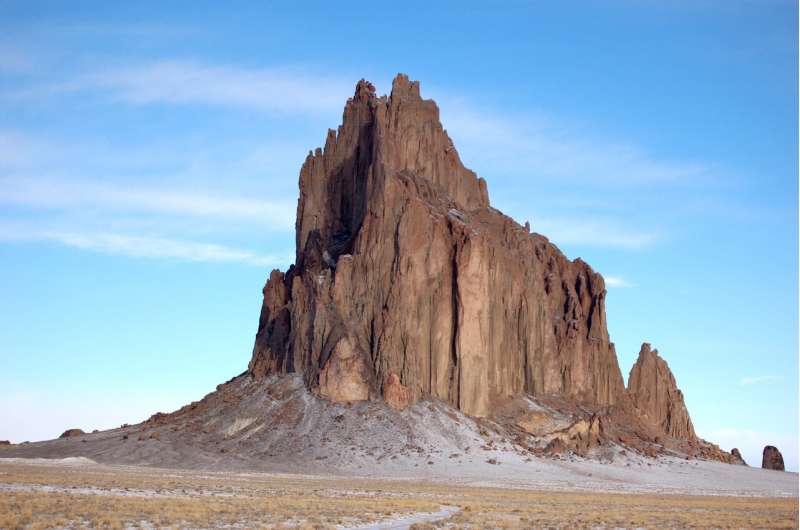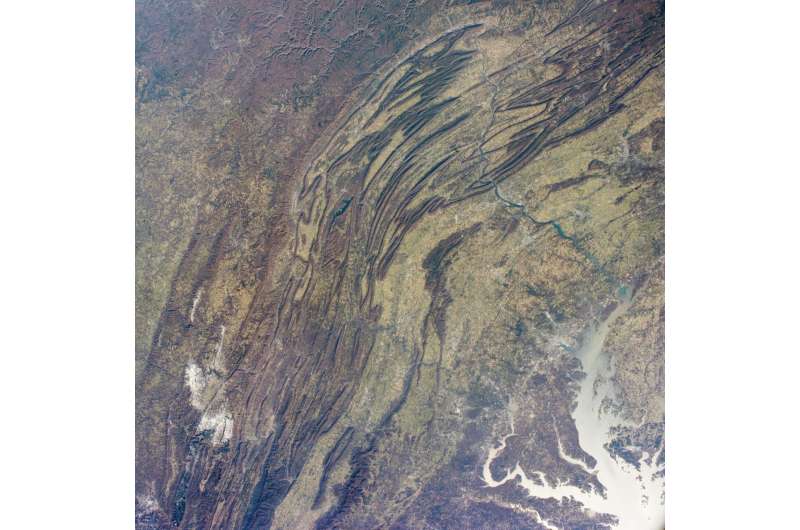Promoting earth's legacy delivers local economic benefits

For iconic landscapes such as Grand Canyon or the Appalachian Mountains, geological features are an integral part of their appeal. Yet despite the seeming permanence of cliffs, caves, fossils, and other geological highlights, these features are surprisingly vulnerable to damage or destruction. Across the U.S., there is a growing awareness that America's geological resources represent a common heritage that needs to be preserved—and that doing so can yield considerable economic and societal benefits.
The notion of a shared geological record is central to the concept of geoheritage: the idea that people, landscapes, and the processes that have formed—and continue to shape—our planet are interconnected. Ways to protect and promote America's geoheritage, and the benefits of doing so, will be the focus of two sessions of talks presented tomorrow at the Geological Society of America's Annual Meeting in Phoenix.
"The only evidence of Earth's long history is the rock record. This can vary dramatically from place to place, so it's crucial to conserve this legacy," says Tom Casadevall, scientist emeritus at the U.S. Geological Survey and chair of the National Academy of Sciences-sponsored U.S. Geoheritage and Geoparks advisory group. "Geoheritage sites are crucial for advancing scientific and public knowledge about important topics like natural hazards, the evolution of life, and our nation's energy and mineral supplies."
In the U.S., sites of geological significance are protected at a variety of management levels and administered by numerous federal land-management agencies, including the National Park Service, the Bureau of Land Management, and the U.S. Forest Service, as well as state, tribal, and local entities. "During the last decade, there has been more and more interest in developing geoheritage sites," says Casadevall. "I have seen first-hand the economic, educational, and social benefits that can be derived from geology-related tourism, and I believe more American communities could benefit from this approach."

State geological surveys are playing a lead role in developing and promoting geology-related sites and educational programs across the country, according to Casadevall. In Florida, the state geologist has the authority to designate state geologic sites deemed important for scientific study as well as public understanding of the state's geological history. Four such sites have been designated to date.
In the central Appalachians, West Virginia University, the West Virginia Geological and Economic Survey, and the U.S. Geological Survey have developed an Appalachian Geo-STEM camp where high school students can engage in geoscience through outdoor adventure education activities. The university is also working with three southern counties to create an Appalachian Geopark that showcases the region's coal, caves, rivers, and other natural attributes and how these underpin the local culture.
Many state surveys also distribute educational materials, develop geo-tours, post blogs, and help catalog geosite attributes to guide tourism development. "State geological surveys play a vital role in translating the geological origins of interesting features into terms that non-scientists can understand," says Nelia Dunbar, New Mexico's state geologist.
In Texas, the Bureau of Economic Geology has begun several educational initiatives, including the Texas GeoSign Project, to promote geoheritage in the Lone Star State. The Arizona Geological Survey is currently cataloging more than 1,500 unpublished geologic and mining documents related to the Santa Cruz Valley National Heritage Area, which was established earlier this year. And the New Mexico Bureau of Geology & Mineral Resources is developing "e-materials" to help curious visitors understand the stories behind state's beautiful scenery and the valuable resources like turquoise that are so closely intertwined with New Mexico's rich cultural history.
"Growing awareness of the power of the 'geoheritage' approach has provided us with a pathway to increase awareness of the links between geology and human history," says Dunbar. "We look forward to increasing our reach and relevance through this new direction."
More information:
Session no. 96 – T184. Geoheritage: Sharing Earth's Legacy for Scientific, Societal, and Economic Advancement I
Room 101C, West Building (Phoenix Convention Center)
Session Link: gsa.confex.com/gsa/2019AM/webp … am/Session47700.html
Session No. 9152 – T184. Geoheritage: Sharing Earth's Legacy for Scientific, Societal, and Economic Advancement II
Room 101C, West Building (Phoenix Convention Center)
Session Link: gsa.confex.com/gsa/2019AM/webp … am/Session48688.html
Provided by Geological Society of America



















